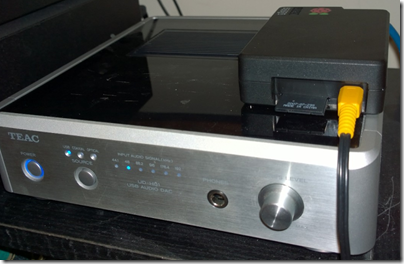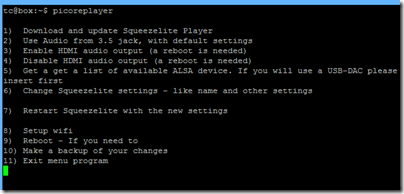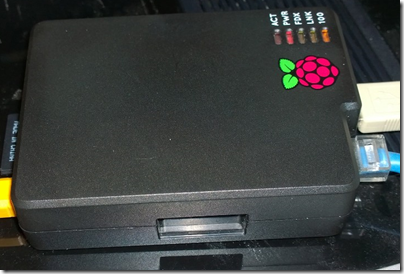I went along to the Audio Lounge in London to hear Sony’s Eric Kingdon (Senior European Technical Marketing Manager) and Mike Somerset (Product Marketing Manager) talk about high resolution audio and demonstrate the HAP-Z1ES player.

The HAP-Z1ES costs £1,999 and plays both DSD (the format of SACD) and PCM formats, including DSDIFF,DSF,WAV,FLAC,ALAC,MP3 and ATRAC. PCM is up to 24-bit/192kHz and DSD up to double DSD (DSD 128). It was demonstrated with the Sony TA-A1E amplifier (also £1999) and the Crystal Cable Arabesque Mini loudspeakers which costs €12,999 (not sure of £ price) including the stands.

This was a small event for customers and there were around 20 attending. Ruth Phypers at the Audio Lounge gave us a warm welcome and conveyed nothing other than enthusiasm for audio; no high-pressure sales here. The talk and demonstration took place in the basement listening room.

High resolution audio is controversial, in that there is evidence that even CD quality (16-bit/44.1 kHz) is good enough to capture everything we can hear in normal music played at normal levels – see Monty Montgomery’s excellent technical explanation and accompanying videos for why – and I was interested to see how Sony is pitching high-res to its potential customers. I was also interested to see if it would broach the tricky subject of DSD vs PCM and whether there is any audible difference.
In this respect it was a curious event as you will see. One of the odd things was that little music was played, maybe 10 minutes out of a one and a half hour presentation.
Somerset kicked things off, explaining the battle between convenience and quality in music reproduction. “We’ve lost a lot in quality” he said, thanks to the popularity of MP3. So what does Sony mean by high-res? Anything beyond CD quality, he said, confusing the issue: is it MP3 that is limiting audio quality today, or CD?
“A lot of people out there think CD, that’s as good as it gets, nothing better, obviously we know that’s not true,” he said.
That said, he made the point that the Z1ES is not just designed for high-res, but to perform well with most formats and resolution. It has a DSEE (Digital Sound Enhancement Engine) which supposedly improves the sound of lossy-compressed audio by “improving the spectrum” (according to the slide; I still have no idea what this means); and a DSD remastering engine that converts lossless PCM to double DSD on the fly (the PCM file remains as-is and it is not stored twice).
Why would you want to do that? I asked Kingdon later who said it was a matter of personal taste; you should take it home and try it. Personally I’m not sure why it should make any difference at all to the sound; you would have thought it would be audibly transparent if the double DSD encoding is doing its job, and if it does sound different it raises the question of whether the DSD conversion ends up colouring the sound; unless perhaps the DAC is more capable with DSD than with PCM. On this latter point Kingdon said no; the Burr-Brown DAC is excellent for PCM. DSD remastering is optional and you can easily enable or disable the feature.
Somerset also explained that the Z1ES does not stream music; it copies audio files to its own internal storage (1TB hard drive). However it can detect when music is added to a network location such as a NAS (Network Attached Storage) drive and copy it automatically. The reason it is copied and not streamed is to eliminate network latency, he said. If 1TB is not enough, you can attach a USB external drive, but this must be reformatted to Ext4 by the system, deleting any existing files.
The Ext4 limitation was a matter of some discussion and discontent among the audience. The Z1ES runs Linux internally, hence the requirement for Ext4, but Linux can mount other file formats successfully so a future firmware update will likely remove this limitation.
Kingdon then answered questions – would the unit go out of date quickly? No, it will have a long life, he promised. Why no video output? “It’s a pure audio product,” he said.
Eventually we got to a demo. Somerset kicked off by playing a Bob Dylan track, Blowing in the Wind (recorded in 1963) in three different formats. The first was 24-bit 88.2 kHz flac (I imagine derived from the DSD used for the SACD release, as conversions from SACD often end up as 24/88). The second was 256kpbs MP3. Finally, there was what he described as a “heavily compressed” MP3, though the exact resolution was not specified. All were derived from the same original source, we were told.
“For me, focusing on the vocals, you can really hear the difference in brightness,” said Somerset.
The odd thing was that (to my ears) the 24/88 version did indeed sound brighter and slightly louder than the MP3, which I find puzzling. I’m not aware of any technical reason why high resolution audio should sound any brighter (or tonally different) from CD or MP3. There was not a dramatic difference in overall quality from what little I could tell in the few seconds of music we heard, but I was not sure that the brighter sound was an improvement; Dylan can sound a little strident at times and the slightly mellower (and dare I say, more analogue-sounding) MP3 version could well be preferred.
We switched back and forth a couple of times, and then Somerset played the “heavily compressed” version. This sounded OK too, from what I could hear of it, which might explain why Somerset talked over it and stopped playing it quickly, saying how bad it was.
Next we heard a DSD download from Blue Coast records; it was Immediately Blessed by Keith Greeninger. This sounded superb, far better than the Dylan, though I doubt this was much to do with formats, but more because it was a modern recording made by a dedicated audiophile label. It was the best sound we heard.
Daft Punk followed, at 24/88.2, and then a 24/96 Linda Ronstadt track from 1983, and then a Nat King Cole song from 1957 in 16/44.1 format.
That was it for demos, if I remember right. What was notable to me was that Sony never demonstrated high-res vs CD quality, played only one DSD track, and used mostly older recordings. Some of these older recordings do indeed sound great, but I doubt it is the best way to demonstrate high resolution audio. If you attended the session as a high-res sceptic you would have heard nothing to change your mind.
Another odd thing was that we heard tracks there were available on SACD but played to us as PCM, most likely converted from the SACD source. Why did we not hear the DSD? It is probably do to with the difficulty all of us have in ripping SACD to audio files, which can only done (as far as I am aware) with a hacked PlayStation 3 with old firmware.
I asked Kingdon why Sony does not make its high-res products like the Z1ES more attractive by giving us the ability to rip SACD at best quality? The record companies would not like it, he said. “I’ve had this discussion so many times, I’ve got a big SACD collection, some of it isn’t available any more, I’m sorry, I don’t have an answer for you.”
Despite some frustration at the brevity and content of the demos, this was an enjoyable event with great hospitality from the Audio Lounge, some fascinating recollections from Kingdon of his time with Sony over many years, and a high level of warmth and friendliness all round.
Now if I were Sony I would use the best possible sources to show off high-res audio and the new player, and avoid misleading comparisons or doubtful technical statements. The fact is that many high-res sources, whether SACD, DVD Audio (which you can easily rip to a player like this) or downloads, do sound excellent, and for many that is more than enough to justify purchase.
Would a beautifully mastered CD or CD-quality download sound just as good? Possibly, and the fact that Sony did not attempt to demonstrate the difference, but compared high-res to MP3, lends support to the idea. If there really is a big difference, why not demonstrate it?
As for the Z1ES itself, I heard enough to know that it can sound very good indeed. It is disappointing that it has no surround sound capability, and no digital input so you could use it as an external DAC, but those are not show-stoppers. For myself I would be more inclined to invest in a standalone DAC, maybe one which is both DSD and PCM capable, but if you like simplicity, then a machine with its own storage, DAC, remote, and handy screen for album artwork does make sense.

























